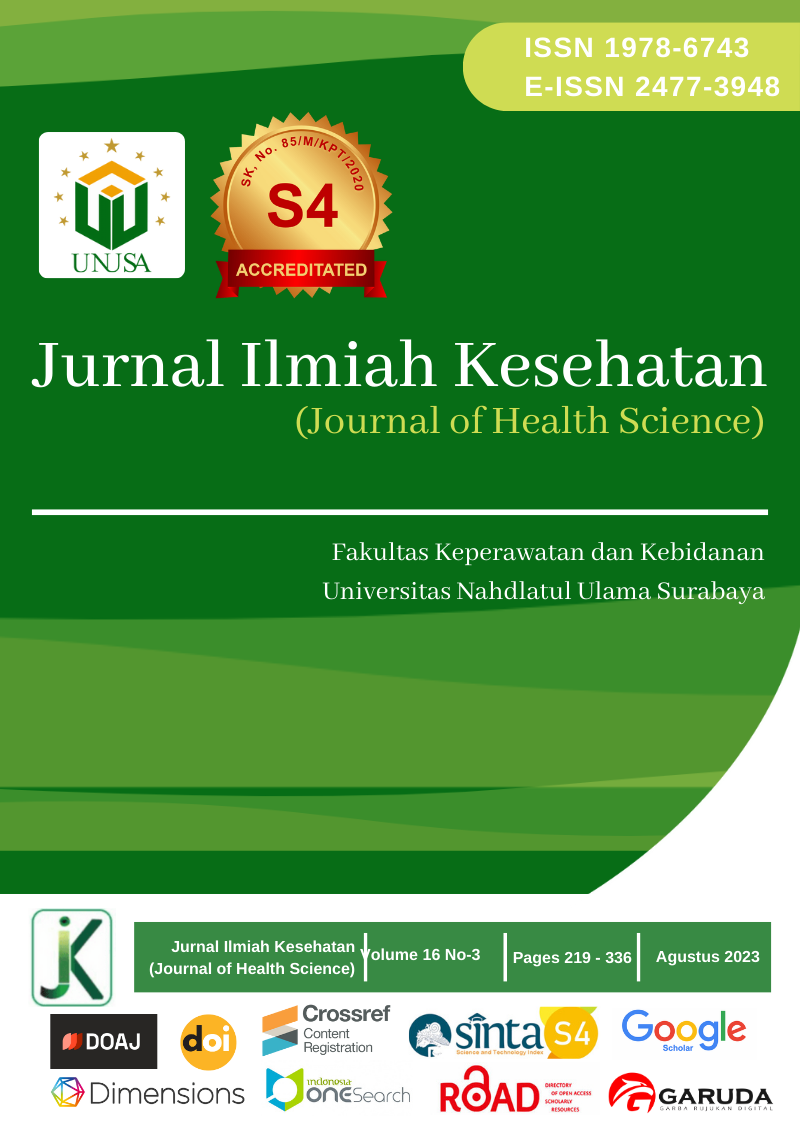Analysis of Related Factors with The Performance of the Midwife in the Handling of Neonatoric Asphycia in the Area of the Health Service of Magelang Regency
Main Article Content
Abstract
The infant mortality rate in the Magelang Regency Health Office area will increase in 2020-2022 from 6.34/1000 KH to 7.38/1000 KH with details of the cause of death due to asphyxia neonatorum 27%. In handling neonatal asphyxia, the role of village midwives is needed to help reduce infant mortality. This study aims to determine the factors that influence the performance of midwives in the service of neonatal asphyxia in the Health Office of Magelang Regency.
The type of research used is observational which is analytic in nature with a cross sectional approach. Data collection was carried out by interviews using a structured questionnaire that had been tested for validity and reliability. Sixty five respondents were selected purposively with inclusion and exclusion criteria. The analysis used is the Chi Square test and multiple logistic regression.
The average age of the respondents was 38 years, 96.9% of the respondents had Diploma III in Midwifery. Most of the respondents (72.3%) had less knowledge, 55.4% had less attitude, 50.8% had less motivation. Most (80%) of the support resources (funds, facilities, infrastructure) are good. Respondents' perception of supervision (52.3%) is good. Most of the respondents (60%) had poor performance in handling neonatal asphyxia. The results of the bivariate analysis showed that knowledge (p = 0.001), attitude (p = 0.0001), motivation (p = 0.0001), perceptions of supervision (p = 0.0001) were related to the performance of village midwives. Multivariate analysis showed that there was a joint relationship between knowledge (Exp.(B) 7.723) and motivation (Exp.(B) 8.324) and the performance of village midwives in handling neonatal asphyxia.
The Health Service needs to provide technical guidance on a regular basis in the management of neonatal asphyxia and increase motivation by giving awards to midwives who work well in the service of neonatal asphyxia.
Downloads
Article Details
Copyright (c) 2023 Hermani Triredjeki Triredjeki, Che’An Ahmad

This work is licensed under a Creative Commons Attribution-ShareAlike 4.0 International License.
References
Admasu, F. T. et al. (2022) ‘The magnitude of neonatal asphyxia and its associated factors among newborns in public hospitals of North Gondar Zone, Northwest Ethiopia: A cross-sectional study’, PLoS ONE, 17(3 March), pp. 1–10. doi: 10.1371/journal.pone.0264816. DOI: https://doi.org/10.1371/journal.pone.0264816
Alfitri, N. A., Bakhtiar, R. and Ngo, N. F. (2021) ‘Hubungan Umur Kehamilan, Jenis Persalinan, Dan Ketuban Pecah Dini Dengan Derajat Asfiksia Neonatorum Di Rsud Abdul Wahab Sjahranie Samarinda Periode 2019 - 2020’, Jurnal Kedokteran Mulawarman, 8(1), p. 19. doi: 10.30872/j.ked.mulawarman.v8i1.6006. DOI: https://doi.org/10.30872/j.ked.mulawarman.v8i1.6006
Arta Mutiara, Fitri Apriyanti, M. H. (2020) ‘Hubungan Jenis Persalinan Dan Berat Badan Lahir Dengan Kejadian Asfiksia Pada Bayi Baru Lahir’, Jurnal Kesehatan Tambusai, 1(2), pp. 42–49. Available at: https://journal.universitaspahlawan.ac.id/index.php/jkt/article/view/1104/887. DOI: https://doi.org/10.56836/journaliskb.v7i2.37
Dg Taha, I., Herini, E. and Ismail, D. (2017) ‘Kejadian asfiksia dan perkembangan anak usia 6-24 bulan di rumah sakit Luwuk, Sulawesi Tengah Neonatal asphyxia and growth development of children aged 6-24 months in Luwuk hospital, Central Sulawesi’, BKM Journal of Community Medicine and Public Health, 33(5), pp. 1–6. DOI: https://doi.org/10.22146/bkm.17051
Dinas Kesehatan Provinsi Jawa Tengah (2019) ‘Profil Kesehatan Provinsi Jateng Tahun 2019’, Dinas Kesehatan Provinsi Jawa Tengah, 3511351(24), p. 61.
Fattuoni, C. et al. (2015) ‘Perinatal asphyxia: A review from a metabolomics perspective’, Molecules, 20(4), pp. 7000–7016. doi: 10.3390/molecules20047000. DOI: https://doi.org/10.3390/molecules20047000
Florencia, M. et al. (2022) ‘Risiko Kejadian Asfiksia pada Bayi Baru Lahir pada Ibu Hamil dengan Preeklampsia’, The Indonesian Journal of Health Science, 14(1), pp. 103–109. doi: 10.32528/ijhs.v14i1.7952.
Handriani, F. (2020) ‘Gambaran ibu dengan bayi asfiksia neonatorum’, pp. 1–55.
Indonesia, M. K. R. (2019) Pedoman Nasional Pelayanan Kedokteran Tata Laksana Asfiksia. Jakarta.
Kartika Sari, A., Sincihu, Y. and Ruddy, T. B. (2018) ‘Tingkat Asfiksia Neonatorum Berdasarkan Lamanya Ketuban Pecah Dini pada Persalinan Aterm’, Online) Jurnal Ilmiah Kedokteran Wijaya Kusuma, 7(1), pp. 84–92.
Kumalasari, I. and Rusella, Z. (2022) ‘Risiko Kejadian Asfiksia Neonatorum Pada Persalinan Kala Ii Memanjang, Air Ketuban Bercampur Mekonium Dan Usia Ibu’, Jurnal Keperawatan Suaka Insan (Jksi), 7(2), pp. 91–97. doi: 10.51143/jksi.v7i2.325. DOI: https://doi.org/10.51143/jksi.v7i2.325
Marwiyah, N. (2016) ‘Hubungan Penyakit Kehamilan dan Jenis Persalinan deangan Kejadian Asfiskisa Neonatorum Di RSUD dr Dradjat Prawiranegara Serang’, NurseLine Journal, 1(2), pp. 258–266. Available at: https://jurnal.unej.ac.id/index.php/NLJ/article/download/4905/3620/.
Moshiro, R., Mdoe, P. and Perlman, J. M. (2019) ‘A Global View of Neonatal Asphyxia and Resuscitation’, Frontiers in Pediatrics, 7(November), pp. 1–6. doi: 10.3389/fped.2019.00489. DOI: https://doi.org/10.3389/fped.2019.00489
Murniati, L., Taherong, F. and Syatirah, S. (2021) ‘Manajemen Asuhan Kebidanan Pada Bayi Baru Lahir Dengan Asfiksia (Literatur Review)’, Jurnal Midwifery, 3(1), pp. 32–41. doi: 10.24252/jmw.v3i1.21028. DOI: https://doi.org/10.24252/jmw.v3i1.21028
Nufra, Y. A. and Ananda, S. (2021) ‘Faktor-Faktor Yang Berpengaruh Terhadap Kejadian Asfiksia Pada Bayi Baru Lahir Di Rsud Fauziah Bireuen Tahun 2021’, Journal of Healthcare Technology and Medicine, 7(2), pp. 661–672. Available at: http://www.jurnal.uui.ac.id/index.php/JHTM/article/view/1579.
Portiarabella, P., Wardhana, A. W. and Pratiningrum, M. (2021) ‘Faktor-faktor yang Mempengaruhi Asfiksia Neonatorum: Suatu Kajian Literatur’, Jurnal Sains dan Kesehatan, 3(3), pp. 538–543. doi: 10.25026/jsk.v3i3.413. DOI: https://doi.org/10.25026/jsk.v3i3.413
Razak, R. (2021) ‘Gambaran Faktor Risiko pada Kasus Asfiksia Neonatorum di RSIA Budi Kemuliaan Jakarta’, Promotif : Jurnal Kesehatan Masyarakat, 11(1), pp. 58–63. doi: 10.56338/pjkm.v11i1.1518. DOI: https://doi.org/10.56338/pjkm.v11i1.1518
Rustan, H. (2022) ‘Faktor-Faktor yang Berhubungan dengan Kejadian Asfiksia Neonatorum DI RSU ST. Madyang Palopo’, Jurnal Fenomena Kesehatan, 5(2), pp. 81–87.
Walas, W. et al. (2020) ‘Methods for assessing the severity of perinatal asphyxia and early prognostic tools in neonates with hypoxic-ischemic encephalopathy treated with therapeutic hypothermia’, Advances in Clinical and Experimental Medicine, 29(8), pp. 1011–1016. doi: 10.17219/acem/124437. DOI: https://doi.org/10.17219/acem/124437
Ye, Z., Wang, W. and Sun, P. (2022) ‘Effectiveness of Nursing Risk Management in Neonatal Asphyxia Resuscitation Care’, Evidence-based Complementary and Alternative Medicine, 2022. doi: 10.1155/2022/5465472. DOI: https://doi.org/10.1155/2022/5465472





